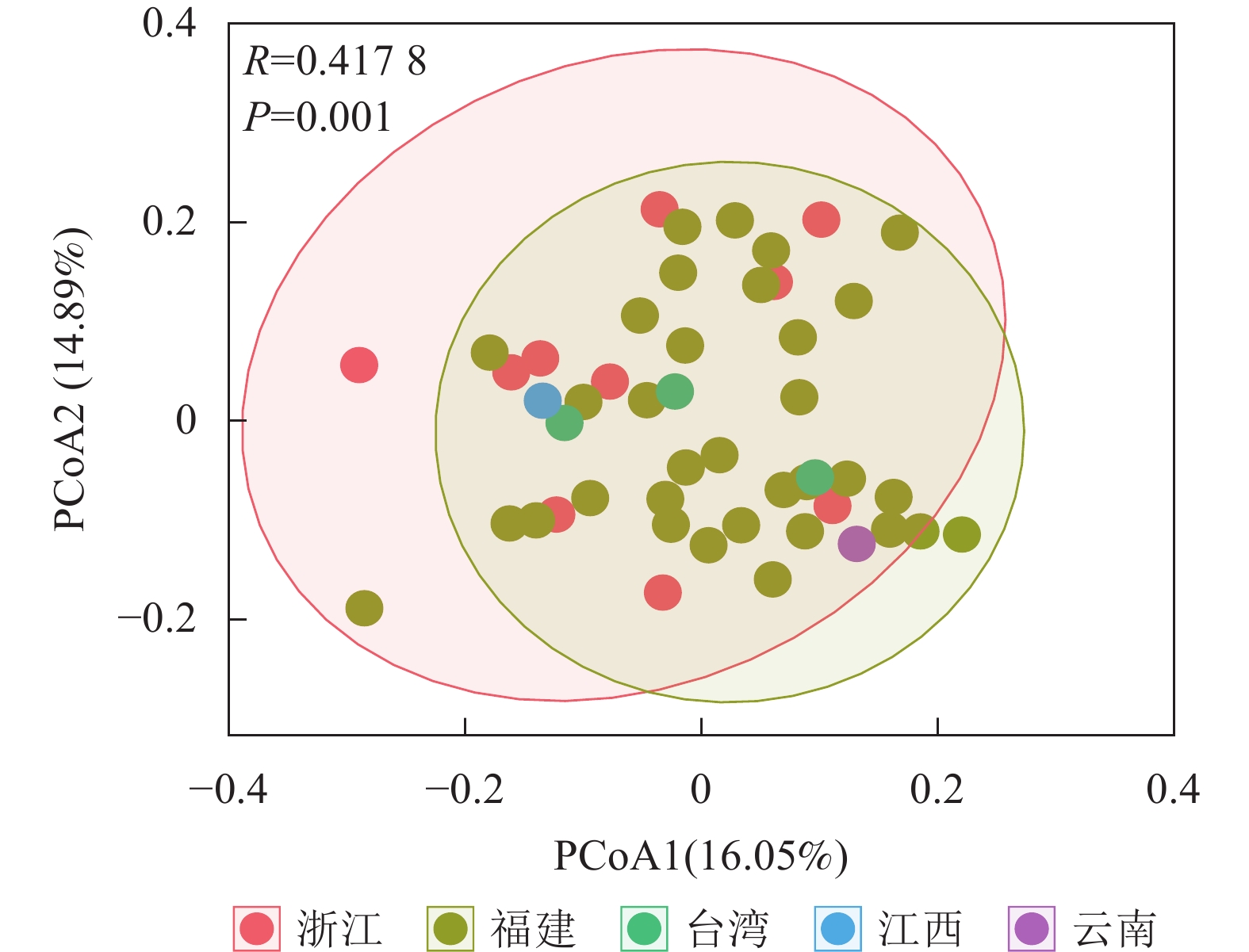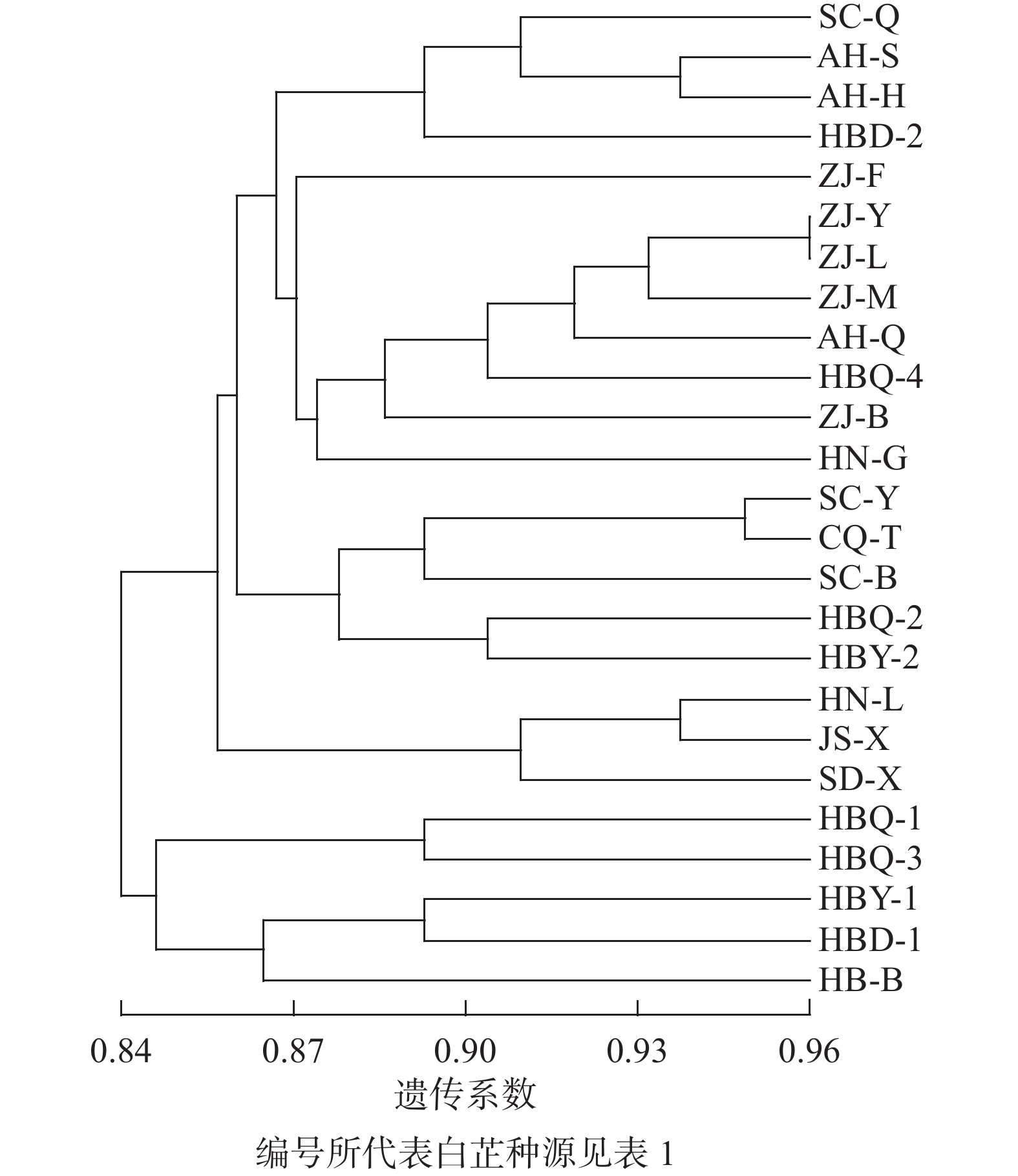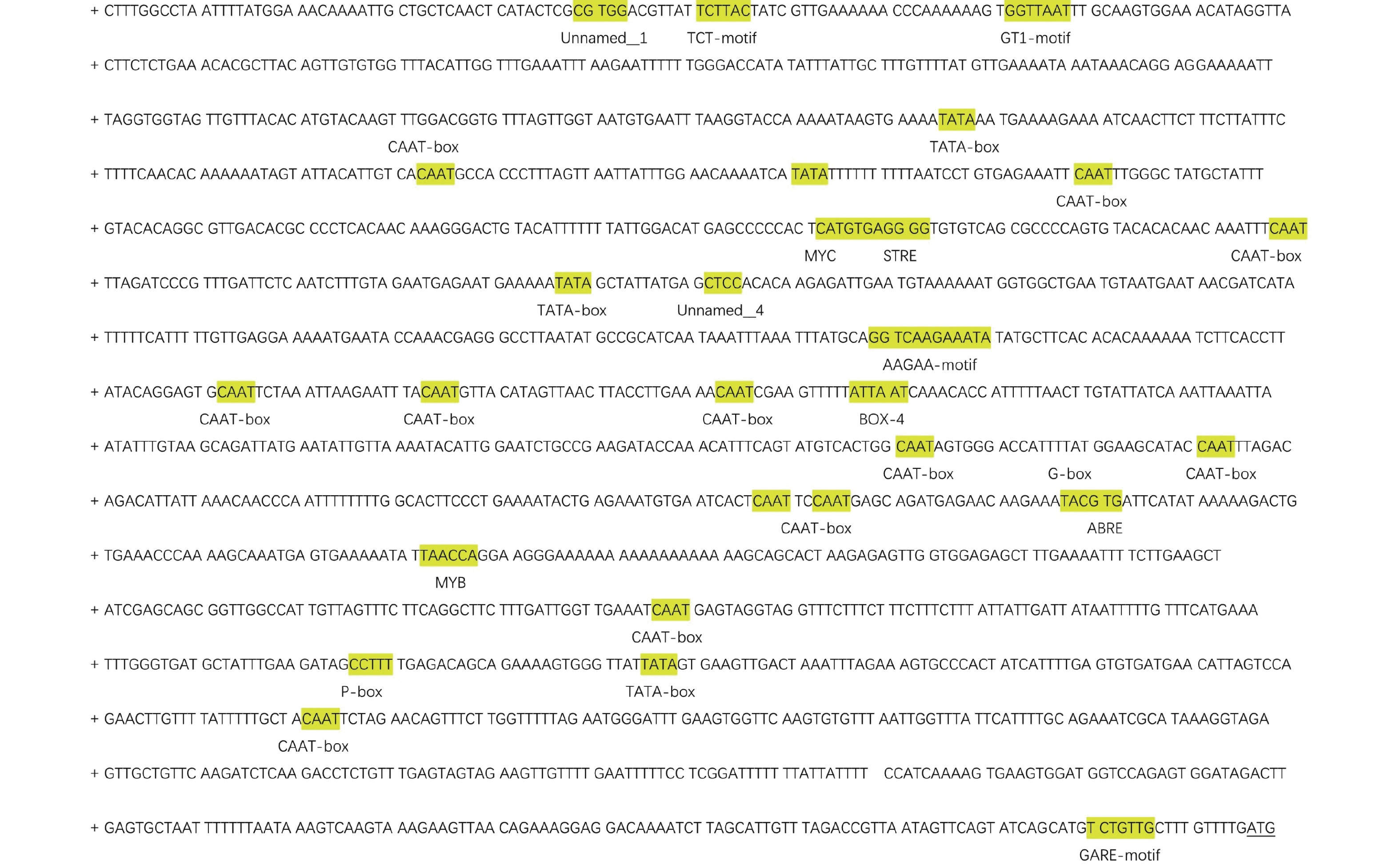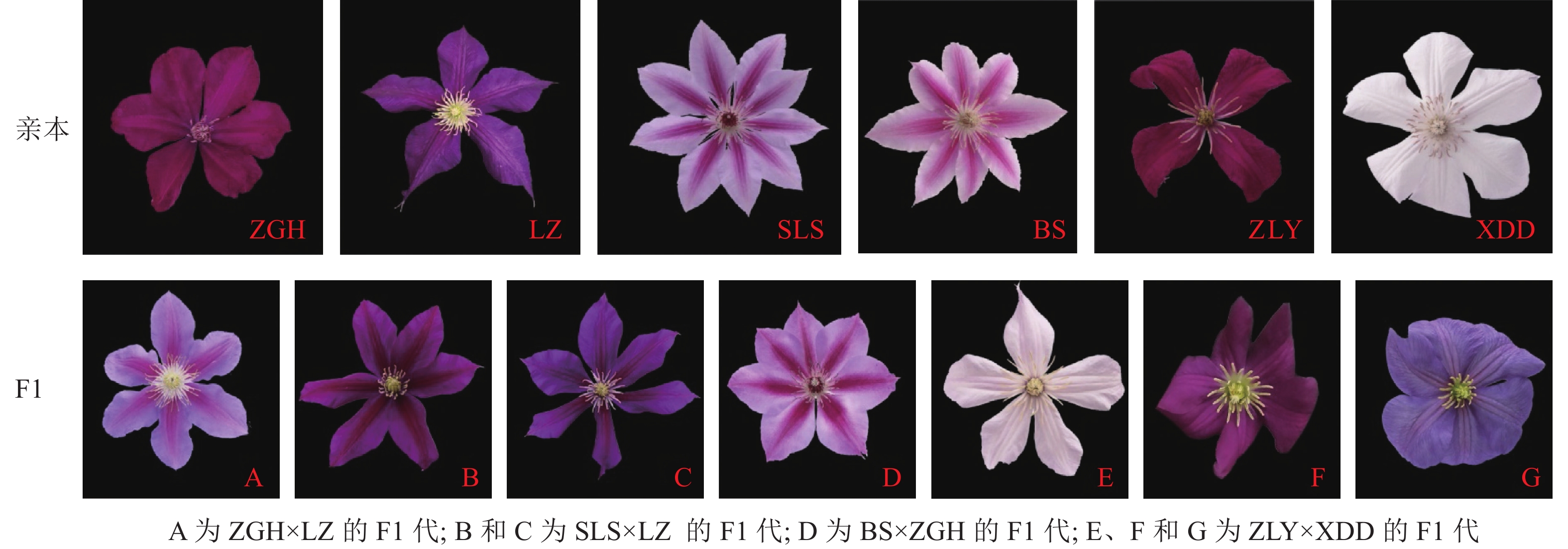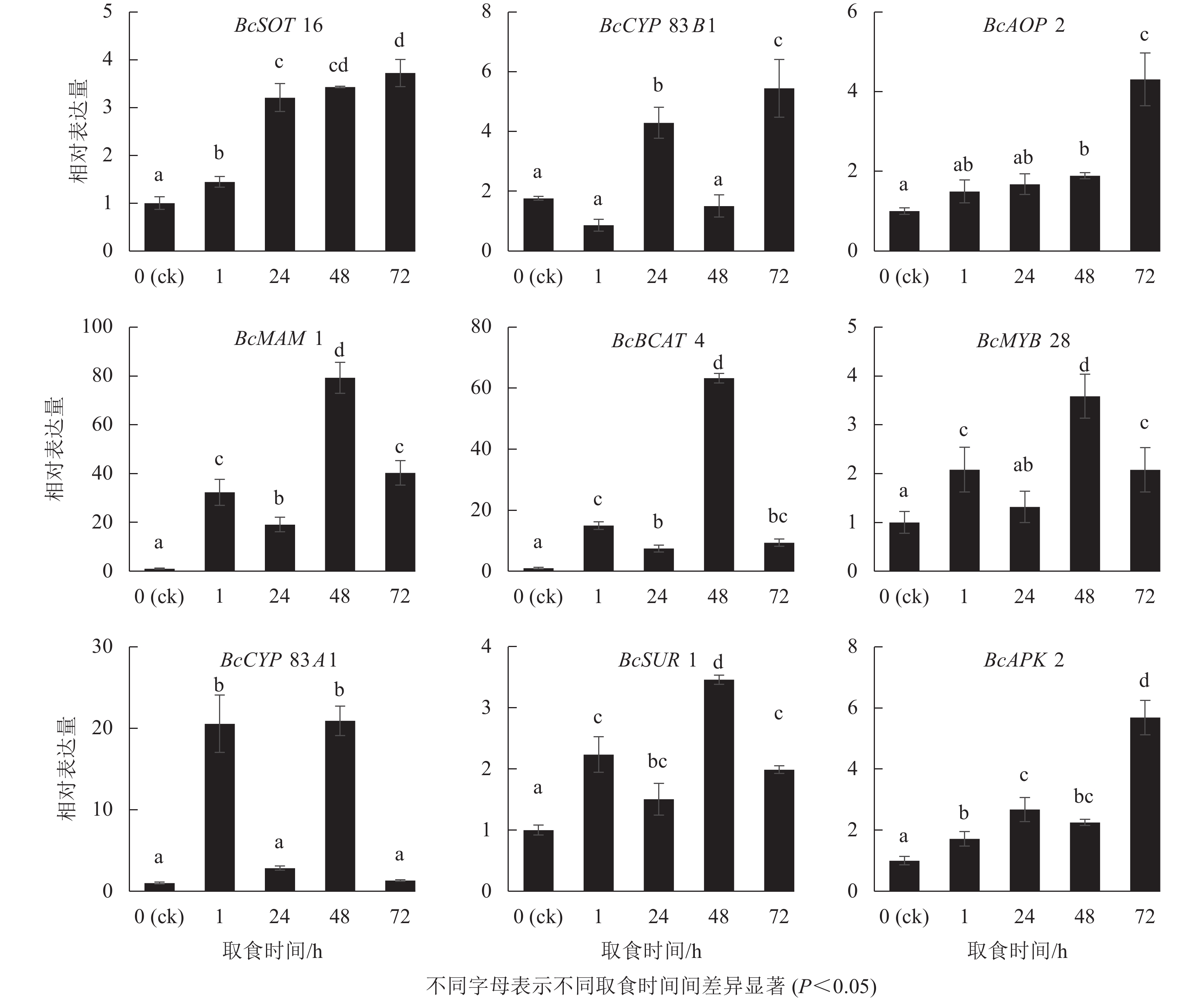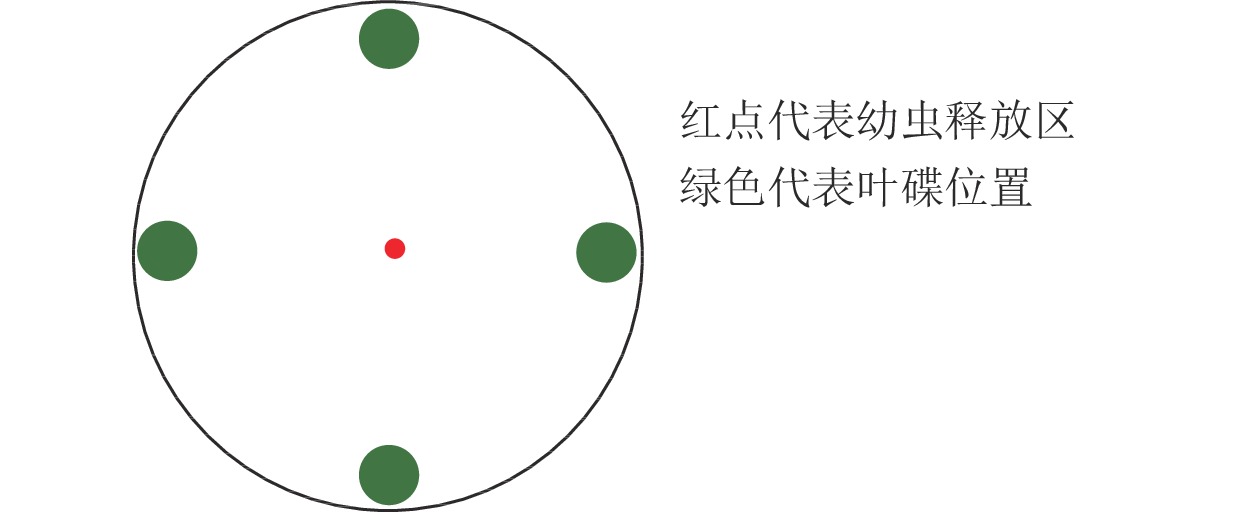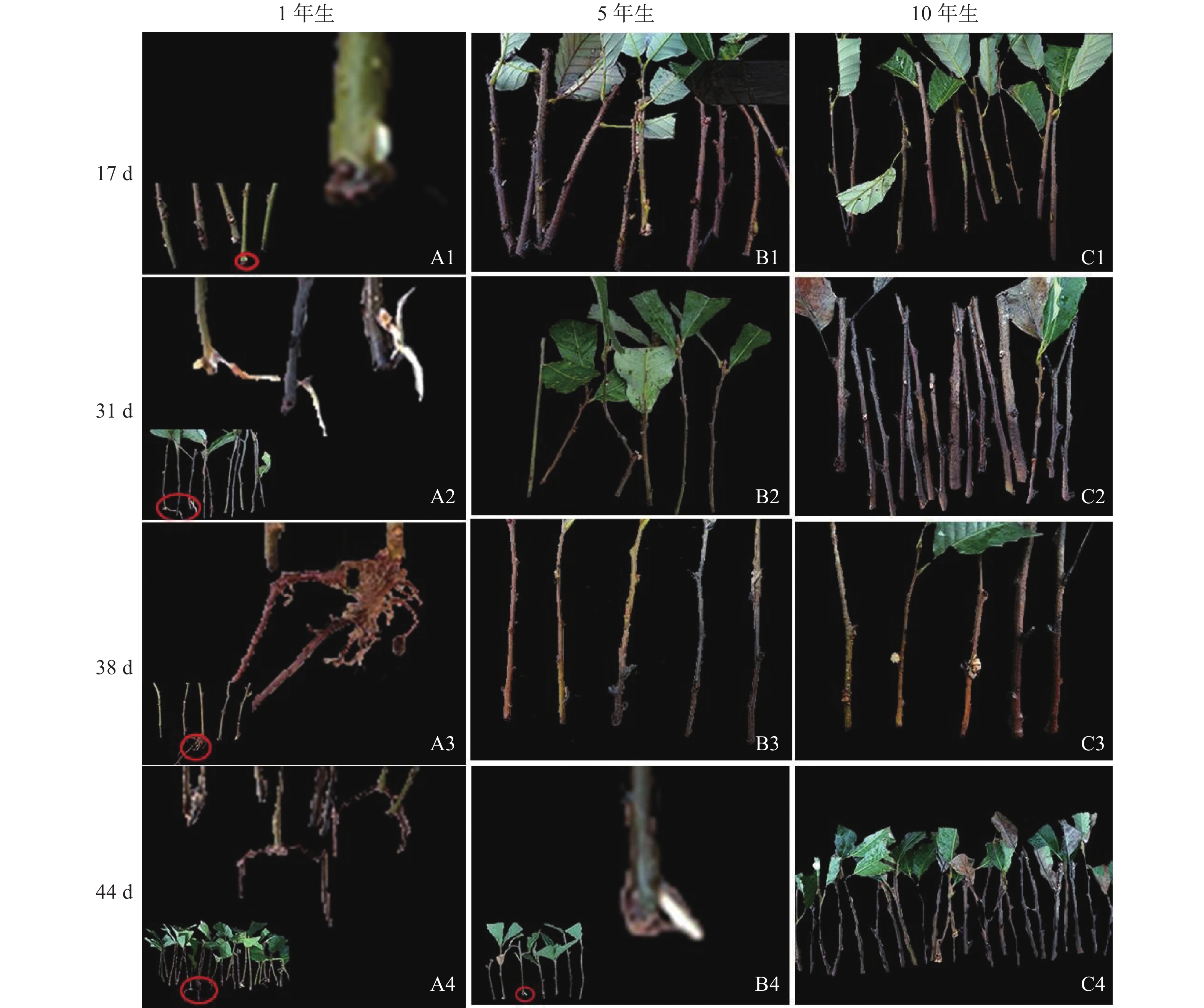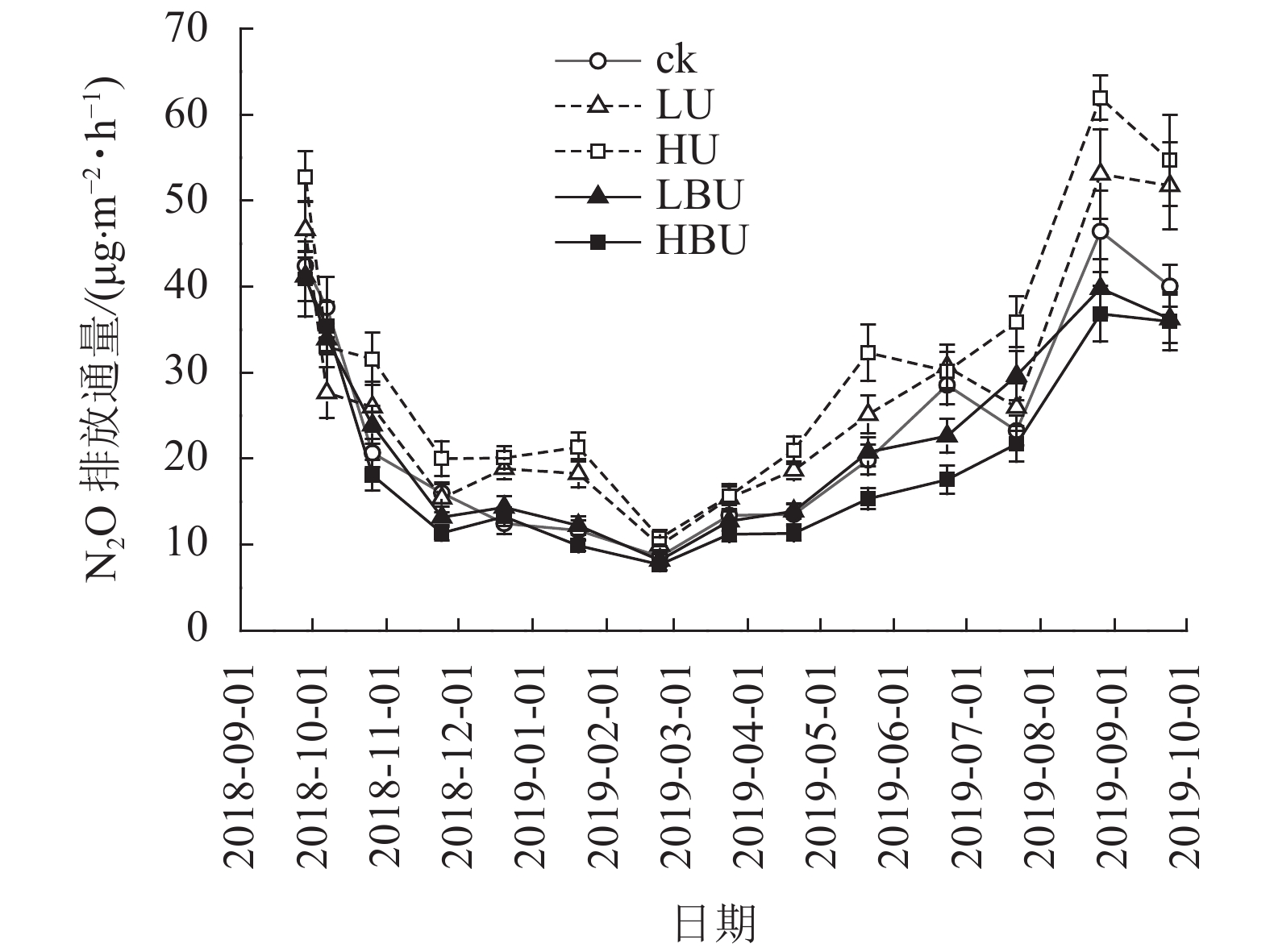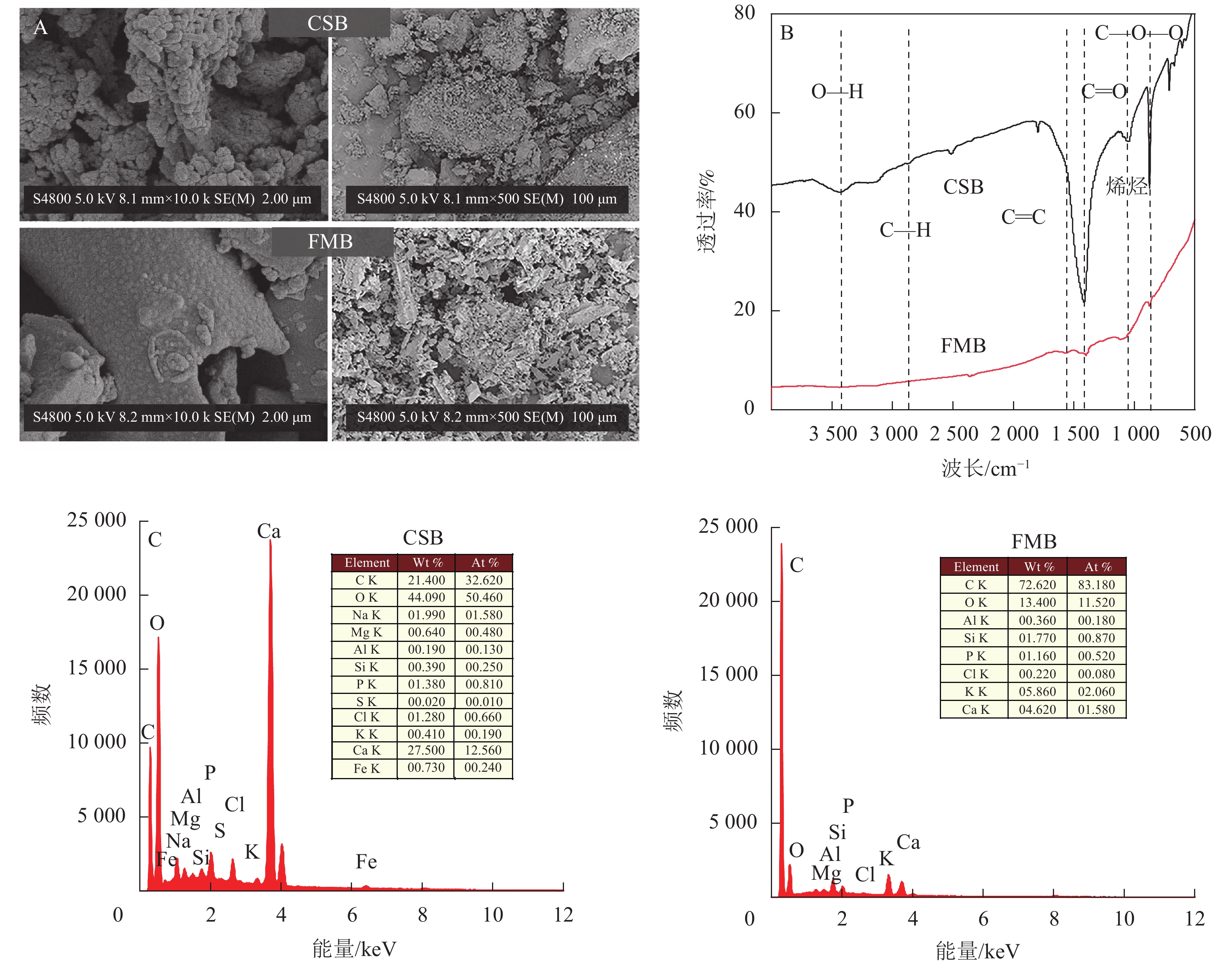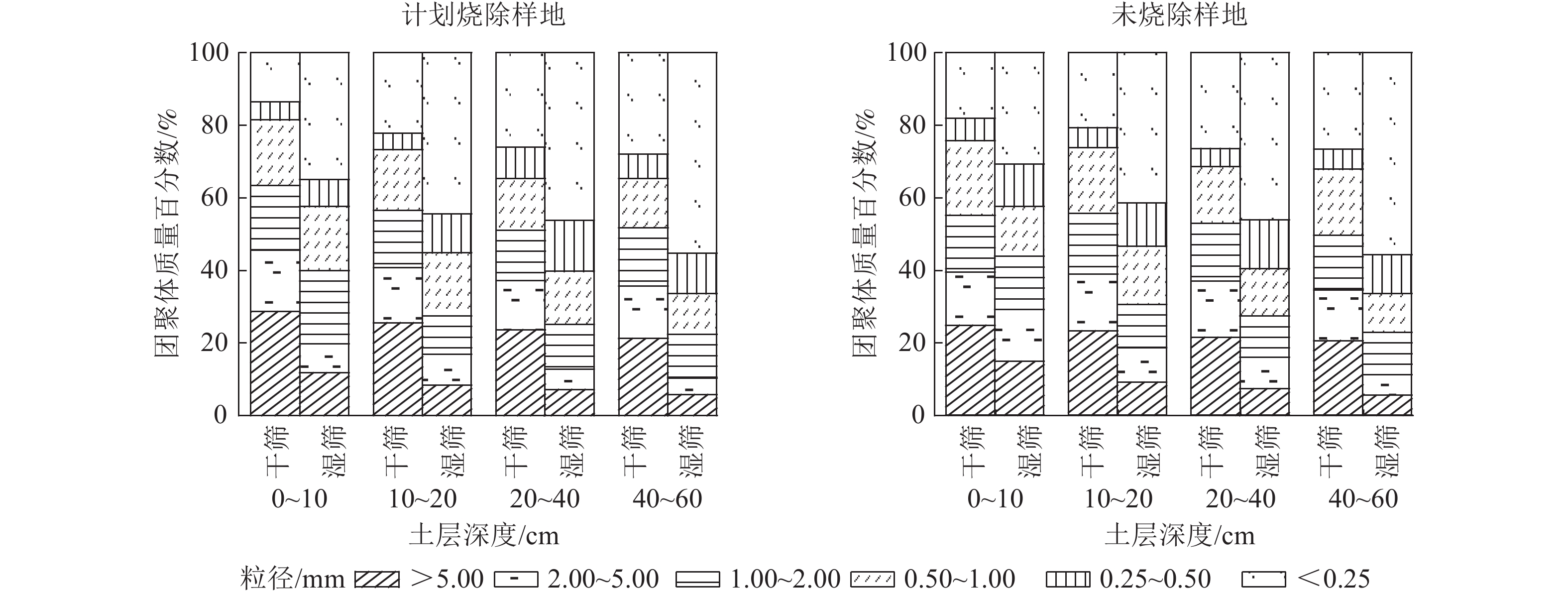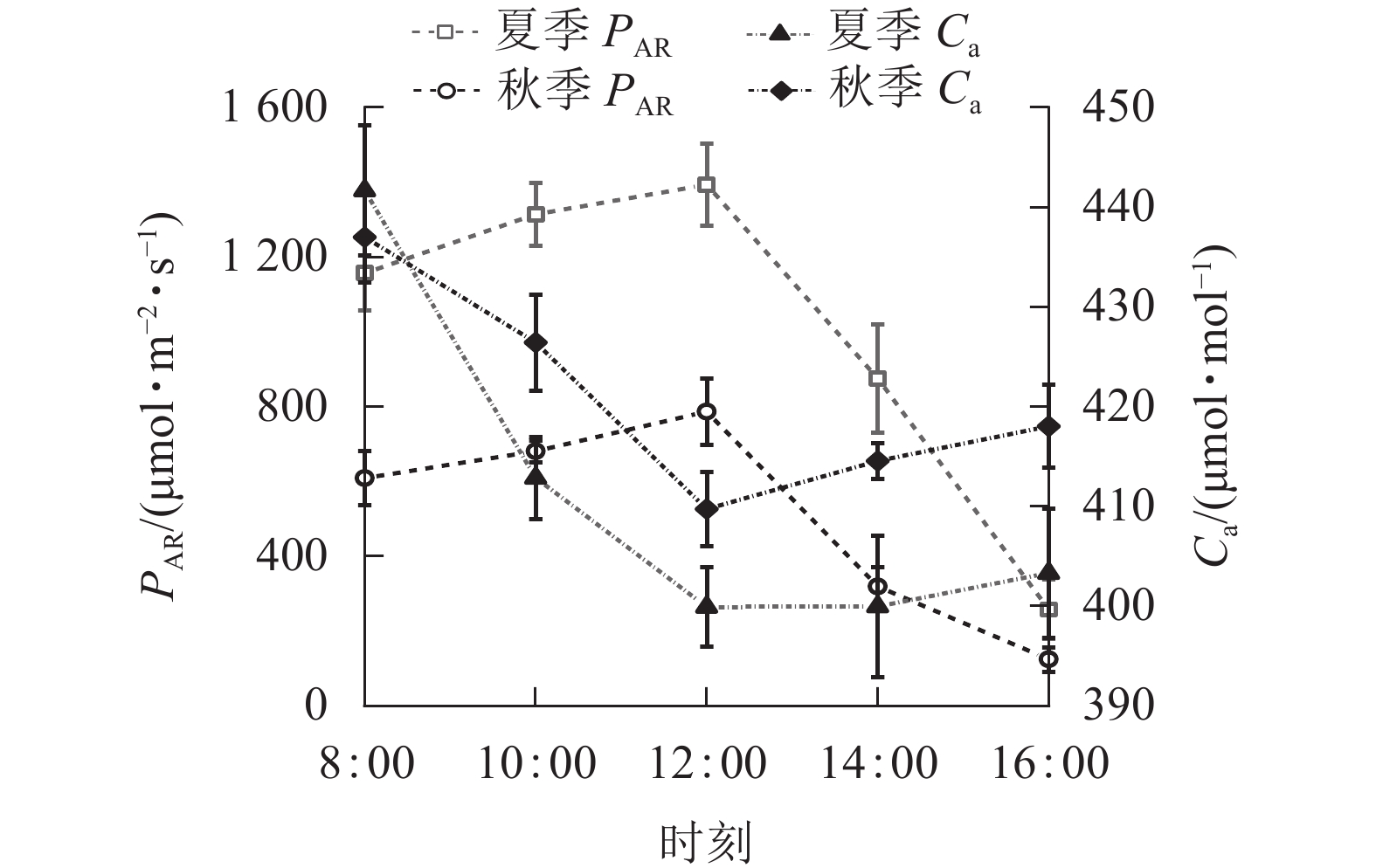2023 Vol. 40, No. 1
2023, 40(1): 1-11.
doi: 10.11833/j.issn.2095-0756.20210725
Abstract:
Objective This study is aimed to explore the distribution and expression characteristics of WOX (Wuschel-related homeobox) transcription factors in Eucommia ulmoides as they play an important role in plant growth and development. Method First, bioinformatics method was employed to identify the genome-wide of EuWOX gene family on the basis of E. ulmoides genome database. Then an analysis was conducted of the expression levels of EuWOXs in E. ulmoides leaf development and Eu-rubber formation based on transcriptomic data. At last, the expression patterns of EuWOXs at different developmental stages of E. ulmoides ‘Ziye’ leaves were detected by real-time quantitative PCR (RT-qPCR). Result Eight EuWOXs were identified in E. ulmoides genome, distributing in eight chromosomes and they were composed of 182−352 amino acid residues with their isoelectric points being 5.10−6.47 and molecular weight between 20.7 to 40.4 kDa. According to the subcellular localization prediction, EuWOXs were all hydrophilic proteins and located in the nucleus. EuWOX gene family was divided into three subfamilies, containing two, one and five EuWOX genes respectively. All EuWOX genes had introns, and each EuWOX protein contains multiple motifs. EuWOXs promoters contained multiple hormones, stress and photoperiod response elemens. The expression level of most EuWOXs in E. ulmoides leaves was low and the expression of EuWOX13-1 gradually decreased with leaf development whereas the EuWOX13-2 expression was the highest in growing leaves. Conclusion Of the eight EuWOXs genes in E. ulmoides, EuWOX13-1 and EuWOX13-2 may play important roles in the leaf development of E. ulmoides. [Ch, 10 fig. 2 tab. 50 ref.]
2023, 40(1): 12-21.
doi: 10.11833/j.issn.2095-0756.20220390
Abstract:
Objective This study, with the identification of the HD-Zip gene family in Schizonepeta tenuifolia and an bioinformatic analysis of its distribution and related characteristics in the whole genome and expression pattern in different stages, is aimed to provide a basis for further study of this gene family. Method Genes in the genome were first screened in accordance with the characterized HD-Zip genes before MEME, Plant CARE, NCBI, MEGA X, MCScanX and Circos were used for the analysis of the basic properties of protein sequences, the construction of Maximum Likeliood (ML) tree, mapping of chromosomes and the analysis of gene structure and colinear gene respectively. Result (1) A total of 42 HD-Zip genes were identified and they could be divided into four subgroups(Ⅰ−Ⅳ), containing 16, 7, 5, 14 genes respectively. (2) The gene length, structure and Motif of the subgroups varied significantly from each though relatively reserved with in each of them. (3) The collinear analysis of the genome of S. tenuifolia and Arabidopsis thaliana showed that 37 pairs of genes may have similar biological functions with light response, abscisic acid response and MeJA response found in cis-elements of 4 subfamily genes promoters of S. tenuifolia, showing different expression profiles in the transcriptome data of different growth stages of leaves and different parts. (4) The HD-ZipⅠ was mainly expressed in young leaves, HD-Zip Ⅱ and Ⅲ were mainly expressed in roots whereas HD-Zip Ⅳ was mainly expressed in leaves. Conclusion The total 42 HD-Zip genes obtained from S. tenuifolia genome were divided into 4 subgroups (Ⅰ−Ⅳ) with highly conserved genes and significant differences among subgroups with their gene structure, motif, and expression pattern being different. HD-ZipⅠ and Ⅱ, and HD-ZipⅢ and Ⅳ are more closely related to each other with HD-Zip genes expressed specifically indifferent tissues and synergistically regulating the growth, development and secondary metabolism of S. tenuifolia. The results of this study provide a bioinformatic reference for the further study of this family’s biological functions. [Ch, 9 fig. 1 tab. 25 ref.]
2023, 40(1): 22-29.
doi: 10.11833/j.issn.2095-0756.20220473
Abstract:
Objective The objective is to study the genetic diversity and genetic relationship among introduced, crossbred and wild samples of Anoectochilus roxburghii in Zhejiang and Fujian Provinces, so as to provide a scientific reference for the identification of germplasm resources of A. roxburghii and the breeding of new cultivars (lines). Method 48 samples of A. roxburghii fresh leaves were used as materials, and 11 pairs of primers with good polymorphism and clear amplification bands were selected by ISSR and SRAP, respectively. After agarose gel electrophoresis imaging, the number of amplified bands was counted, and UPGMA clustering analysis was performed using NTSYS-PC 2.1 and POPGENE 32 software. Result A total of 86 bands were amplified by ISSR, including 84 polymorphic bands (PPB = 97.67%). A total of 88 bands and 86 polymorphic bands were amplified by SRAP, and the PPB was 97.73%. Both ISSR and SRAP markers showed high polymorphism. The genetic distance and genetic consistency between different samples indicated that the germplasm of A. roxburghii in Zhejiang and Fujian was seriously mixed, while the genetic diversity in Fujian was higher. In addition, the UPGMA clustering results based on ISSR+SRAP markers showed that the 48 samples from different provenances could be divided into 4 major groups according to the distance of their genetic relationship. The classification of clusters was affected by certain regions, but the cultivars in each region were mixed in the 4 categories. Conclusion The genetic diversity of A. roxburghii is relatively high at the species level, and genetic exchanges among regions and cultivars are frequent. The genetic diversity of A. roxburghii in Zhejiang and Fujian can be revealed at the molecular level by ISSR and SRAP molecular markers, and the analysis results of ISSR and SRAP markers combined are better than those of single molecular markers. [Ch, 4 fig. 3 tab. 24 ref.]
2023, 40(1): 30-37.
doi: 10.11833/j.issn.2095-0756.20220427
Abstract:
Objective This study is to clarify the genetic differences of Angelica dahurica provenances in different producing areas in China, and analyze the quality characteristics of A. dahurica provenances with genetic differences under the same nursery cultivation conditions. Method The sequence-related amplified polymorphism (SRAP) molecular markers were used to analyze the genetic composition of different provenances of A. dahurica. Taking A. dahurica from different provenances cultivated in the same nursery as materials, the chemical components of 7 coumarins were determined by high performance liquid chromatography (HPLC), and HPLC fingerprints were constructed to analyze the quality characteristics of different provenances. Result Unweighted pair-group method with arithmetic means (UPGMA) showed that some provenances of A. dahurica from Hebei Province and those from South China were separated at the similarity coefficient of 0.84. Under the same nursery cultivation conditions, only 7 coumarins could not be used to clearly distinguish different provenances of A. dahurica. After principal component analysis (PCA) by HPLC fingerprint, the quality characteristics were differentiated between provenances. Conclusion The genetic similarity of A. dahurica provenances from different producing areas is relatively large, and the medicinal materials from some Zhejiang A. dahurica provenances cultivated in the same nursery can be distinguished from those from other producing areas by HPLC fingerprint. [Ch, 3 fig. 4 tab. 20 ref.]
2023, 40(1): 38-44.
doi: 10.11833/j.issn.2095-0756.20220217
Abstract:
Objective UNUSUAL FLORAL ORGANS (UFO) gene belongs to the F-box gene family and is one of the most important floral organ identity genes. The N-terminal of UFO gene can combine with Skp1 genes to form Skp1-Cullin1-F-box (SCF) complex, which participates in the ubiquitination process and degrades the target protein binding with the C-terminal. In order to explore the effect of C-terminal sequence on the flower development of Solanum nigrum, a C-terminal deleted SnUFO2* gene was cloned and its expression vector was constructed transferred into S. nigrum plants to observe the changes of floral organs of transgenic S. nigrum plants, so as to further explore the important role of the complete C-terminal sequence of UFO gene in the flower development of S. nigrum. Method Comparative analysis of SnUFO2* and full-length SnUFO2 was performed using bioinformatics analysis software. Moreover, the expression levels of SnUFO2* in roots, stems, leaves, and buds of wild-type S. nigrum were analyzed by real-time quantitative PCR (RT-qPCR); the function of the SnUFO2* gene was verified by the construction of over expression vector, observation of phenotype of transgenic plants, and the employment of paraffin section technique. Result The ORF length of SnUFO2* was 1 302 bp, encoding 433 amino acids, when compared with the complete SnUFO2 in S. nigrum, the C-terminal of which was missing 23 amino acids. RT-qPCR results showed that SnUFO2* was specifically expressed in the buds of wild-type plants. The phenotypic observation of transgenic plants demonstrated that the petals of 35S::SnUFO2* transgenic S. nigrum plants transformed into sepals. Paraffin section analysis presented that the stamens of transgenic S. nigrum plants were missing and uncertain meristem was produced in the pistil. Conclusion 35S::SnUFO2* transgenic plants lead to abnormal development of petals, stamens, and carpels of S. nigrum. The deletion of the C-terminal structure may reduce the ability of SnUFO2 protein to specifically recognize target proteins, indicating that the complete C-terminal of the gene is important for organ development of S. nigrum. [Ch, 5 fig. 1 tab. 23 ref. ]
2023, 40(1): 45-54.
doi: 10.11833/j.issn.2095-0756.20220205
Abstract:
Objective This study, with mulberry (Morus) fruits as the subjects, is aimed to conduct an investigation into its fruit abscission, a common physiological process which limits the yield of fruit so as to clarify the underlying abscission mechanism of the metabolism and biochemical reactions. Method High-throughput sequencing was employed to conduct transcriptome analysis of the young fruit of Morus alba in the abscission zone between the abscised and normal surviving mulberry fruits to screen the differentially expressed genes before they were subjected to functional annotation and metabolic pathway analysis, and the verification of transcriptome data using real-time quantitative PCR technology. Result A total of 262.92 Mb of raw reads and 10 481 differentially expressed genes were obtained by Beijing Genomics institution (BGI, Shenzhen, China), of which 5 239 were up-regulated, whereas 5 242 were down-regulated; As was shown by the GO functional enrichment analysis, a total of 37 significant items were found, and most of the differentially expressed genes were featured with catalytic activity, membrane composition, oxidoreductase activity and membrane intrinsic components. It was shown by the KEGG enrichment analysis that most differentially expressed genes were concentrated in metabolic pathways such as citric acid cycle, plant hormone signal transduction pathway, and flavonoid biosynthesis. Conclusion Mulberry is regulated by plant hormones and substances such as amino acids, flavonoid secondary metabolites and carbohydrates during the abscission process. [Ch, 9 fig. 2 tab. 35 ref.]
2023, 40(1): 55-63.
doi: 10.11833/j.issn.2095-0756.20220170
Abstract:
Objective The purpose is to explore whether the shrub species of Magnolia sinostellata could adapt to the high temperature in the city and promote its application. Method The 1-year-old seedlings of M. sinostellata were treated with high temperature at 40 ℃ to determine the fructose, glucose, sucrose, starch carbon assimilates, fructose phosphatase, sucrose phosphate synthase, and transcriptome sequencing. Result With the extension of stress time, the contents of fructose, glucose, sucrose and starch in leaves of M. sinostellata were changed, but the difference was not significant(P>0.05). The fructose synthase was significantly decreased (P<0.05), but the sucrose synthase was not significantly changed (P>0.05). Transcriptomic data further revealed that SS (Unigene 40295), Glc-1-pa (Unigene 38453) and GBE (CL4668.contig3) regulated starch synthesis at 48 h compared with 24 h under heat stress. The expression of GBE (CL4668. contig3) gene increased, and the SPS gene that regulates sucrose synthesis decreased with the deepening of heat stress. The above results were verified by qPCR. Conclusion All results indicated that M. sinostellata had a certain short-term tolerance to extreme temperature of 40 ℃. In order to cope with high temperature stress, not only the carbon assimilates were significantly changed, but also the expression of key genes regulating starch and sucrose metabolism were changed. It was further proved that high temperature could lead to mutual conversion of sucrose and starch in the leaves of M. sinostellata. [Ch, 4 fig. 3 tab. 25 ref.]
2023, 40(1): 64-71.
doi: 10.11833/j.issn.2095-0756.20220110
Abstract:
Objective This paper aims to investigate the regulation of high temperature and abscisic acid (ABA) on promoters of three carotenoid biosynthesis genes in Osmanthus fragrans including PSY, PDS, HYB, providing the research foundation for regulation of carotenoid biosynthesis in O. fragrans. Method According to the sequences in genome database of O. fragrans, promoters of OfPSY, OfPDS, OfHYB were cloned from an O. fragrans cultivar ‘Yanhong Gui’, which were used for bioinformatics analysis. Then, these promoters were inserted into PCAMBIA3301-LUC vectors and used for transient expression in tobacco(Nicotiana benthamiana) leaves under treatments of high temperature (37 ℃) and 200 mg·L−1ABA. Result Our research cloned the promoter of OfPSY, OfPDS and OfHYB from genomic database of O. fragrans in length as 1908 bp, 1521 bp and 1830 bp respectively. All three promoters contain promoter basic elements TATA-box and CAAT-box, light response element, ABA response element as well as the binding site of MYB and MYC. Moreover, there was gibberellins (GA) response element in OfPSYP; OfPDSP contains methyl jasmonate (MeJA) and GA response element, pathogen induction element as well as element involved in defense and stress responsiveness; OfHYBP contains hormone response elements as auxin, ethylene and MeJA, as well as low temperature response element and pathogen induction element. The assays of in transient expression in tobacco leaves showed that relative high temperature can activate the promoter activities of OfPSY, OfPDS and OfHYB, and ABA can activate the promoter activities of OfPDS and OfHYB. Conclusion High temperature and ABA probably affect the carotenoid accumulation in O. fragrans by regulating the promoter activities of carotenoid biosynthesis genes. [Ch, 4 fig. 5 tab. 28 ref.]
2023, 40(1): 72-80.
doi: 10.11833/j.issn.2095-0756.20220214
Abstract:
Objective This study, with an analytical comparison of the phenotypic traits between cross parents and F1 generation of Clematis, is aimed to explore the genetic variation of Clematis. Method Four cross combination experiments were conducted to statistically analyze the phenotypic traits of F1 generation with six Clematis cultivars as parents. Result (1) Compared with those of the parents, the flowering stage of F1 generation was separated, but mostly between the parents. (2) There is a general color separation within the F1 generation with the heritability of violet higher than that of red purple, and that of violet and purple more recessive than that of red purple whereas the anther color of F1 generation was not separated with yellow anther relatively dominant to pink and red anther. (3) The sepal width, leaf length and leaf width of F1 generation showed superparental traits, with the total mean values being 111%, 114% and 119% of the median parental values respectively; the pedicel length, flower diameter, sepal aspect ratio and leaf aspect ratio of F1 generation were lower than those of both parents, with the total average values of the offspring being 85%, 89%, 91% and 82% of the median parental values while the sepal length and segment spacing of F1 generation did not change significantly, with the total mean values being 98% and 102% of the median parental value respectively. (4) There were significant correlations (P<0.05) between five quantitative traits in flower and four quantitative traits in leaf, and leaf length was positively correlated (P<0.01) with leaf width, with the highest correlation coefficient of 0.940, which tended to be linked inheritance. Conclusion Most of the phenotypic traits (except anther color) in the offspring generation changed, with only sepal length and segment spacing showing maternal inheritance. On the hand, sepal width showed paternal inheritance, while nine traits, including flowering stage, flower color, anther color, pedicel length, flower diameter, sepal aspect ratio, leaf length, leaf width, and leaf aspect ratio, showed no obvious genetic tendency. [Ch, 1 fig. 7 tab. 24 ref.]
2023, 40(1): 81-88.
doi: 10.11833/j.issn.2095-0756.20220172
Abstract:
Objective With an investigation of the effects of Spodoptera exigua larvae feeding on the content and components of glucosinolates (GSLs) in Brassica campestris ssp. chinensis, this study is aimed to figure out the initial molecular mechanism of GSL-mediated resistance to the feeding stress of S. exigua larvae in B. campestris ssp. chinensis. Method The effect of larvae feeding on the content and components of GSLs in B. campestris ssp. chinensis ‘Meiduheiyoutong’was determined with the application of high performance liquid chromatography before an analysis was conducted of the expression patterns of key genes related to GSLs metabolism using real-time fluorescence quantitative polymerase chain reaction (RT-qPCR), after which the activity of glutathione S-transferase (GSTs) in larvae after eating B. campestris ssp. chinensis was detected by GSTs kit. Result (1) Of the eight GSLs that enjoyed a significant increase in B. campestris ssp. chinensis after S. exigua larvae’ s feeding, 4-hydroxy-glucobrassicin (4OH), 1-methoxy-glucobrassici (NEO), glucobrassicin (GBC) and glucobrassicanapin (GBN) were the four important GSLs responsive to the feeding; (2) The significant up-regulation of aliphatic GSL synthesis-related genes BcBCAT4 and BcMAM1 in B. campestris ssp. chinensis might be related to the increase of aliphatic GSLs, and the up-regulation of BcSOT16 was positively correlated with 4OH, NEO and GBC after feeding by S. exigua larvae; (3) After feeding, the activity of GSTs in the larvae of S. exigua was significantly enhanced (P<0.05), and showed a consistency with the changes of the total GSLs and indole GSLs. Conclusion Feeding by S. exigua larvae can induce the synthesis of GSLs in B. campestris ssp. chinensis, and the increase of GSLs can induce the enhancement of GSTs activity in larvae. Under the feeding stress of S. exigua larvae, the activation of key GSLs synthesis genes such as BcSOT16, BcBCAT4 and BcMAM1in B. campestris ssp. chinensis may promote the increase of 4OH, NEO, GBC and GBN which will help better resist S. exigua larvae feeding stress. [Ch, 2 fig. 3 tab. 43 ref.]
2023, 40(1): 89-96.
doi: 10.11833/j.issn.2095-0756.20220168
Abstract:
Objective This study aims to investigate the tropism response of Phthonoloba viridifasciata larvae to host plants and chemical compounds in leaves of host plants, so as to provide scientific reference for the development of attractants for P. viridifasciata. Method The selection of the 2nd instar larvae of P. viridifasciata to different leaf disc combinations was determined by petri dishes in the laboratory. The crude extracts of host plants were prepared with hexane and the chemical compounds were analyzed by gas chromatography-mass spectrometry (GC-MS). Chi square test was used to compare the taxis selection of the larvae of P. viridifasciata to different treatments. Result (1) Under light and dark conditions, the selection frequency of P. viridifasciata towards Alsophina spinulosa and A. metteniana were significantly higher than that towards green leaf discs (P<0.01) when A. spinulosa and A. metteniana were paired with green leaf discs. Under light conditions, the selection ratio under light (A. spinulosa 68.7%, A. metteniana 78.3%) was slightly lower than that under darkness (A. spinulosa 81.7%, A. metteniana 80.0%). (2) Under dark conditions, the selection frequency of the larvae of P. viridifasciata to the host plants A. spinulosa and A. metteniana were significantly higher than that to the non-host plants Arachniodes chinensis and Nephrolepis auriculata (P<0.01). (3) Under dark conditions, when the leaves and discs of 4 ferns coexisted, the selection frequency of A. spinulosa by the larvae of P. viridifasciata was significantly higher than that of the other 3 ferns (P<0.05), in which the selection frequency of A. spinulosa was the highest, up to 46 times, accounting for 38.3% of the total frequency. (4) At least 30 compounds were detected by GC-MS, including 23 from A. spinulosa, 19 from A. metteniana, and 8 shared compounds such as γ-sitosterol, stigmastanol, 2-propenoic acid, 3-(4-methoxyphenyl)-, 2-ethylhexyl ester, nonanal, and other alkanes. The chemical compounds in leaves of A. spinulosa and A. metteniana were mainly hydrocarbons, followed by alcohols and aldehydes. Conclusion The larvae of P. viridifasciata have a strong ability to distinguish host plants from non-host plants, and can be attracted by host plants A. spinulosa and A. metteniana. Mixture of 3-Hexen-1-ol, (Z)- and nonanal can be used as attractants for P. viridifasciata. [Ch, 2 fig. 4 tab. 38 ref.]
2023, 40(1): 97-106.
doi: 10.11833/j.issn.2095-0756.20220247
Abstract:
Objective This study, with an exploration of the allelopathic effects of understory litter extracts from different stand types of Robinia pseudoacacia on seed germination and embryo growth, is aimed to clarify causes of the difficulty in seedling regeneration under R. pseudoacacia forest. Method With the litter extracts of R. pseudoacacia plantation used as the source of allelochemicals and the seeds of R. pseudoacacia being the subjects of study, the Petri dish filter paper method was emoloyed to analyze the effects of the understory litter extracts of different management generations and different stand ages on the germination rate, germination potential, germination speed index, vigor index and embryo growth of R. pseudoacacia. Result (1) The litter extracts under the R. pseudoacacia forest inhibited the germination and embryo growth of R. seudoacacia and the inhibitory effect of the litter extract on the growth of the radicle was stronger than that of the embryo. (2) There were significant differences between different forest types and different concentrations in the second-generation forest and the third-generation forest, the inhibitory effect of R. pseudoacacia litter extract on seed germination and embryo growth decreased with the increase of forest age. (3) In the first-generation forest, the litter extracts of middle-aged forests could promote seed germination, but had a weak inhibitory effect on embryo growth with the allelopathic effect composite index being 0.006 and −0.032 respectively. (4) In middle-age forests, the inhibitory effect of R. pseudoacacia litter extract on seed germination and embryo growth increased with the increase of forest generations. (5) In mature forests, with the increase of forest generations, the inhibitory effect of the litter extract on seed germination showed an increasing trend with the allelopathy composite index increased from 0.044 to 0.097, whereas the inhibitory effect on embryo growth showed a decreasing trend, with the allelopathy composite index falling from 0.124 to 0.050. (6) The litter extract in some forest types had a concentration effect, and its inhibitory effect on seed germination and embryo growth weakened as the concentration decreased. Conclusion The litter extracts of different stand types of R. pseudoacacia undergrowth have an inhibitory effect on their own seed germination and embryo growth. In the second and third generation stands, the litter extract showed a weakening effect on the seed germination and embryo growth of R. pseudoacacia with the increase of stand age. In young-aged and middle-aged forests, the inhibitory effect of litter extract on seed germination and embryo growth of R. pseudoacacia increased with the increase of forest generation. In other words, continuous planting hinders the natural regeneration of seedlings of R. pseudoacacia, but as the forest age increases, the hindering effect on the regeneration of seedlings will be weakened. [Ch, 3 fig. 1 tab. 38 ref.]
2023, 40(1): 107-114.
doi: 10.11833/j.issn.2095-0756.20220143
Abstract:
Objective This study aims to explore the effect of mother tree age on the cutting rooting of Quercus variabilis as well as the possible causes, so as to provide basis for the cutting propagation of Q. variabilis. Method The semi-lignified shoots of 1, 5 and 10-year-old oak mother trees were soaked with 200 mg·L−1 root powder (ABT-1) for 2 h. The rooting rate, rooting number, root diameter, root length and activities of polyphenol oxidase (PPO), peroxidase (POD) and IAA-oxidase (IAAO) were determined after 60 d. The changes of tissue structure of stem segments of cuttings at different ages were observed by paraffin sectioning. Result (1) The older the mother tree was, the lower the cutting rooting rate was. (2) The adventitious root primordium of Q. variabilis was induced in the late stage of adventitious root formation. The adventitious root generation time of cuttings at different ages was different (17 d for trees of 1 year old , 44 d for 5 years old, and none for 10 years old). (3) The activities of IAAO, PPO and POD in the cuttings of 1-year-old and 5-year-old mother trees showed a single-peak trend of ‘first increasing and then decreasing’, while the activities of POD in the cuttings of 10-year-old mother trees showed an increasing trend. The activities of PPO and IAAO did not change significantly. Conclusion The age of mother trees affects the generation of adventitious roots of cuttings. The rooting rate and the average adventitious root number of Q. variabilis softwood cuttings from high to low are trees of 1 year old, 5 years old and 10 years old, with an average rooting rate of 92.69%, 10.79%, and 0, respectively. The rooting type of Q. variabilis is dermal rooting type and its adventitious root primordium is induced root primordium. High levels of POD and PPO activity are conducive to adventitious root induction, while increased IAAO activity is conducive to adventitious root formation. [Ch, 3 fig. 1 tab. 30 ref.]
2023, 40(1): 115-125.
doi: 10.11833/j.issn.2095-0756.20220223
Abstract:
Objective This study tries to reveal the response of Pinus yunnanensis seedling growth and nutrient accumulation to exogenous N and P combined application, and to provide a theoretical basis for optimizing nutrient management and seedling cultivation of P. yunnanensis. Method 2-year-old potted seedlings of P. yunnanensis were taken as the research objects. 9 different fertilization treatments were set to analyze the effects of different fertilization treatments on the growth and nutrient accumulation of P. yunnanensis seedlings, including ck (no fertilization), P1 (P, 0.8 g per seedling), P2 (P, 1.6 g per seedling), N1 (N, 0.4 g per seedling), N2 (N, 0.8 g per seedling), N1P1 (N, 0.4 g per seedling, P, 0.8 g per seedling), N1P2 (N, 0.4 g per seedling, P, 1.6 g per seedling), N2P1 (N, 0.8 g per seedling, P, 0.8 g per seedling), N2P2 (N, 0.8 g per seedling, P, 1.6 g per seedling). Result The total biomass and seedling quality of each fertilization treatment were higher than those of ck, and those of N1P1 treatment were the highest. The nutrient accumulation of each organ ranging from large to small was leaf, stem and root. The N, P and K reserves of organs and individual plants of different fertilization treatments were significantly different from those of ck (P<0.05), and increased in different degrees compared with ck. The seedlings under N1P1 treatment had the largest N and K reserves in root, stem and individual plant, and the largest P reserves in root, stem, leaf and individual plant, while the seedlings under N2P1 treatment had the largest N and K reserves in leaf. The distribution pattern of N, P and K nutrients was leaf, stem and root from large to small. Conclusion N and P combined application significantly improves biomass accumulation, seedling quality, as well as nutrient accumulation in each organ. It also increases the nutrient distribution of root and stem, and decreases the nutrient distribution of leaf. The combined application of N and P is superior to the single application of either N or P. Therefore, N1P1 is the optimal treatment. [Ch, 6 fig. 5 tab. 38 ref.]
2023, 40(1): 126-134.
doi: 10.11833/j.issn.2095-0756.20220226
Abstract:
Objective This study, with an investigation of the physiological and biochemical responses of roots in Pinus massoniana seedlings to different phosphorus (P) concentrations, is aimed to explore the physiological and biochemical mechanisms of P. massoniana in response to low P stress, so as to provide theoretical support for the managements of P. massoniana plantations in low phosphorus area. Method First, two-year-old seedlings of P. massoniana planted in potted with quartz sand were treated with six available P concentrations, including 0 (P0)、0.562 5 (P1)、1.125 0 (P2)、2.250 0 (ck)、4.500 0 (P3)、9.000 0 (P4) mg·kg−1 before a control check (ck, 2.250 0 mg·kg−1) with the effective phosphorus content of the national P. massoniana forest soil survey. Then, the physiological and biochemical characteristics of roots, including activities of acid phosphatase (ACP), total organic acid content (TOC), root vigor, malondialdehyde (MDA) and activities of three antioxidant protective enzymes including superoxide dismutase (SOD), peroxidase (POD) and catalase (CAT), were determined and analyzed in both 1.5 and 3.0 months after treatments. Result (1) Both ACP activity and organic acid content decreased with the increase of phosphorus concentration with the ACP activity of P0 in August and September being significantly higher than that of ck (P<0.05), and the ACP activity of P4 being significantly lower than ck both in August and September (P<0.05) whereas in September, the ACP activity of P3 was also significantly lower than that of ck (P<0.05) with the organic acid content in P0 and P1, and organic acid content in P4 being significantly lower than in ck (P<0.05) in two sampling times. (2) In August, the root vigor in ck was significantly lower than in P0, P1, P3 and P4 (P<0.05), and in September, the root vigor increased with the increase of phosphorus concentration. (3) The root MDA content increased with the decrease of phosphorus concentration with the MDA content in P0 being significantly higher than that in ck (P<0.05), and the MDA content in P4 being significantly lower than that in ck (P<0.05). The antioxidant enzyme activities showed a tendency of increasing as phosphorus concentration decreased whereas SOD, POD and CAT were significantly higher in P0 and P1 than that in ck (P<0.05) though their activities showed no significant variation among ck, P2, P3 and P4 treatments. Conclusion In response to low P stress, P. massoniana seedlings had their MAD, ACP, TOC and antioxidant system enzyme activities increased in roots with the root vigor regulated. [Ch, 3 fig. 1 tab. 39 ref.]
2023, 40(1): 135-144.
doi: 10.11833/j.issn.2095-0756.20220254
Abstract:
Objective The aim of this study is to explore the effect and mechanism of the application of biochar-based urea and common urea on soil N2O flux and environmental factors in Phyllostachys edulis forest, so as to provide scientific basis for the development of fertilization technology to reduce soil N2O emissions. Method A field control experiment was carried out in a typical subtropical Ph. edulis forest in Qingshan Town, Lin’an District of Hangzhou from September 2018 to September 2019. 5 treatments were set up: control (ck), low-level urea (100 kg·hm−2), high-level urea (300 kg·hm−2), low-level biochar-based urea (100 kg·hm−2) and high-level biochar-based urea (300 kg·hm−2). Soil N2O flux of Ph. edulis forest was determined by static chamber-gas chromatography, and the dynamic changes of soil N2O flux, temperature and water content, nitrogen forms and related enzyme activities were analyzed under the above fertilization treatments. Result Low-level urea and high-level urea treatments increased the annual cumulative N2O emission by 17.3% and 36.0%, while low-level biochar-based urea and high-level biochar-based urea treatments reduced it by 3.1% and 16.9%, respectively. Both urea and biochar-based urea treatments significantly increased soil NH4 +-N and NO3 –-N concentrations (P<0.05). Urea treatment significantly increased the concentration of soil water-soluble organic nitrogen and activities of urease and protease, while biochar-based urea treatment significantly decreased the values of these 3 indicators (P<0.05). In addition, under the above 5 treatments, there was a significant correlation between soil N2O emission rate and soil temperature, NH4 +-N, water-soluble organic nitrogen, urease and protease activities. Conclusion Compared with urea, biochar-based urea has a significant reduction effect on soil N2O flux in Ph. edulis forest, and the key mechanism lies in that biochar-based urea reduces concentration of soil water-soluble organic nitrogen and activities of N-cycling enzymes. [Ch, 5 fig. 3 tab. 55 ref.]
2023, 40(1): 145-154.
doi: 10.11833/j.issn.2095-0756.20220213
Abstract:
Objective This study aims to reveal the spatial variability of soil nutrients and the influencing factors in subtropical national nature reserves of China, so as to provide a theoretical basis for protecting rare vegetation and natural ecosystems in China’s subtropical hilly regions. Method Soil samples were collected from Longtangshan-Shunxiwu in Qingliangfeng Nature Reserve of Zhejiang Province. Classical statistics and geostatistical method were used to systematically analyze the soil variables such as pH, soil organic matter (SOM), total nitrogen (TN), total phosphorus (TP) and total potassium (TK), and the main influencing factors were explored. Result The soil in the study area was acidic as a whole. The average contents of SOM, TP, TN and TK were 65.04, 0.67, 1.63 and 18.45 g·kg−1, respectively, which belonged to moderate variation. Semi variance analysis showed that SOM, TN and TK displayed strong spatial autocorrelation while pH and TP displayed moderate spatial autocorrelation, indicating that the soil nutrients were mainly affected by structural factors. The global Moran’s I index revealed that the spatial autocorrelation of SOM reached a significant level and its spatial distribution was aggregated, while the distribution of soil pH tended to be random. Kriging interpolation results showed that the spatial distribution of various nutrients was fragmented and the patch characteristics were significant. Correlation analysis showed that SOM and TN were significantly correlated with altitude, bulk density, and slope (P<0.05), and there was a significant positive correlation between SOM and TN (P<0.01). Conclusion All the soil nutrients show an obvious spatial heterogeneity. Altitude and bulk density are strongly correlated with the spatial variation of SOM and TN in the study area. [Ch, 6 fig. 4 tab. 38 ref.]
2023, 40(1): 155-163.
doi: 10.11833/j.issn.2095-0756.20220289
Abstract:
Objective This research aims to study the stoichiometric characteristics of leaf litter at different decomposition stages in different stands in southwest Guizhou Province, so as to better understand the nutrient cycling law of different forest ecosystems in karst areas. Method 4 typical forest types were selected in southwest Guizhou, including Pinus massoniana forest, Phyllostachys edulis forest, Cunninghamia lanceolata forest, and natural forest dominated by Quercus acutissima, Machilus cavaleriei and Cyclobalanopsis glaucoides. Leaf litter at different decomposition stages was collected and stoichiometric characteristics of C, N and P were measured. Result (1) The total C content of leaf litter in each decomposition stage of P. edulis forest was significantly lower than that in other stands (P<0.05), and the total C content of leaf litter at decomposed stage of P. massoniana and C. lanceolata forests was significantly lower than that at undecomposed and semi-decomposed stages (P<0.05). The total N content of leaf litter in C. lanceolata forest at undecomposed stage was significantly lower than that at semi-decomposed and decomposed stages (P<0.05). The total P content of leaf litter at decomposed stage of natural forest was significantly higher than that in other stands (P< 0.05), and the total P content at semi-decomposed stage of natural forest was significantly lower than that at undecomposed and decomposed stages (P< 0.05). (2) The C/N ratio of C. lanceolata forest at decomposed stage was significantly higher than that of Ph. edulis forest (P<0.05), and the C/N ratio at undecomposed stage was significantly higher than that at semi-decomposed and decomposed stages (P<0.05). The N/P ratio at undecomposed and decomposed stages of Ph. edulis forest was significantly higher than that of natural forest (P<0.05). The C/P ratio of leaf litter at semi-decomposed stage of C. lanceolata and natural forests was significantly lower than that of P. massoniana forest (P< 0.05), and the C/P ratio at decomposed stage of natural forest was significantly lower than that of other stands (P<0.05). Conclusion Both forest type and decomposition stage have significant effects on contents of total C, N and P, as well as stoichiometric characteristics of leaf litter. [Ch, 2 fig. 2 tab. 36 ref.]
2023, 40(1): 164-175.
doi: 10.11833/j.issn.2095-0756.20220138
Abstract:
Objective This study aims to investigate the impact of different understory vegetation management measures on soil respiration and its components in Eucalyptus urophylla × E. grandis plantation on Leizhou Peninsula, so as to provide a reference for accurate evaluation of soil carbon cycle in Eucalyptus plantation. Method Understory vegetation removal was conducted in 2 ways (physical removal and herbicide treatment) in E. urophylla × E. grandis plantation, and the non-removal group was used as the control. The LI-8100A automatic soil carbon flux measurement system was used to continuously monitor total soil respiration and its component rates, soil temperature and humidity (5 cm deep) for 1 year. Result Physical and chemical removal of understory vegetation significantly reduced total soil respiration and its components (except chemical removal of root respiration) (P<0.01). In addition, the total soil respiration rate of physical removal (3.45 μmol·m−2·s−1) was significantly lower than that of chemical removal (4.15 μmol·m−2·s−1) (P<0.01). There was no significant difference between the two approaches in mineral soil respiration rate and litter layer respiration rate. The root respiration rate showed physical removal (1.02 μmol·m−2·s−1) was significantly lower than that of chemical removal (1.37 μmol·m−2·s−1)(P<0.05). The contribution rates of litter layer respiration, mineral soil respiration, and root respiration to total soil respiration were 36.45%−39.40%, 26.34%−31.29%, and 30.10%−39.40%, respectively. The highest value of total soil respiration rate and its components occurred in the rainy season (April−October) and the lowest value of root respiration rate occurred in July and August. The fitting model of soil total respiration rate with soil temperature and humidity was the best, which could explain 75.1% (physical removal), 60.9% (chemical removal) and 57.1% (control) of the variation of soil total respiration rate. The temporal variation of litter respiration rate was mainly controlled by soil moisture; There was no significant correlation between root respiration rate and soil temperature, but a significant negative correlation with soil moisture (P<0.05). The temperature sensitivity (Q10) of total soil respiration was 2.12 for physical removal, 1.95 for chemical removal, and 1.93 for control. Conclusion The removal of understory vegetation affects soil respiration by changing biological and abiotic factors in the forest. Compared with chemical removal, physical removal of understory vegetation can reduce the total soil respiration rate and carbon emission of forest soil to a greater extent. [Ch, 4 fig. 3 tab. 49 ref.]
2023, 40(1): 176-187.
doi: 10.11833/j.issn.2095-0756.20220182
Abstract:
Objective This study aims to investigate the effects of biochar derived from Procambarus clarkii shells (CSB) and Ficus microcarpa (FMB) on physicochemical properties of contaminated soil and plant growth. Method The biochar was prepared by pyrolysis of both typical kitchen and garden wastes at 650 ℃ with limited oxygen supply. A pot trial was conducted using Raphanus sativus with different mass ratios (0, 1%, 3%) to investigate the effects of different doses of CSB and FMB on cadmium (Cd) and lead (Pb) bioavailability in soil, nutrient transformation, soil enzyme activity, and R. sativus growth. Result 3% FMB treatment had the most significant effect on improving contents of soil organic carbon, available phosphorus and available potassium (P<0.05), which increased by 135.8%, 35.4%, and 173.7% respectively compared with the control. Except 1% CSB treatment, other biochar treatments significantly (P<0.05) decreased the concentrations of available Cd by 60.7%−91.1% and Pb by 21.0%−26.1%. 3% CSB treatment showed significant increase in soil enzyme activities such as β-glucosidase, leucine aminopeptidase and β-N-acetylglucosamine (P<0.05), which were 79.7%, 30.3% and 1668.5% higher than that of the control, respectively. All biochar treatments significantly (P< 0.05) increased the biomass of the edible part of R. sativus. 3% CSB treatment had the most significant improvement effect (P< 0.05), which increased by 171.5% compared with the control. Conclusion The CSB is more effective than the FMB in improving soil enzyme activity, reducing Cd and Pb bioavailability in soil, and improving crop quality and yield. It is more suitable as a potential material for the remediation of soils co-contaminated with Cd and Pb. [Ch, 7 fig. 1 tab. 46 ref.]
2023, 40(1): 188-197.
doi: 10.11833/j.issn.2095-0756.20220321
Abstract:
Objective Prescribed burning is an essential measure for forest fire prevention. The purpose of this study is to explore the impact of prescribed burning on soil anti-erodibility and anti-scourability of Pinus yunnanensis forest, so as to provide scientific basis for sustainable forest management and optimization of prescribed burning in forest areas. Method The sample plots of P. yunnanensis forest in central Yunnan Plateau were selected as the research objects. The effects of prescribed burning on soil anti-erodibility and anti-scourability of P. yunnanensis forest were systematically studied by combining field investigation and sampling with indoor experimental analysis. Result (1) After prescribed burning, the content of mechanically stable aggregates(>2.00 mm) in 0−40 cm soil layer increased and the content of waterstable aggregates (>2.00 mm) decreased. The mean mass diameter and mean geometric diameter of the water stable aggregates decreased. The damage rate of soil aggregate structure increased, and the erosion resistance index decreased. The soil erosion resistance index of 40−60 cm soil layer did not change significantly. (2)After the prescribed burning, the litter accumulation decreased and the water holding capacity and storage capacity of the litter weakened, and the plant root system was burned. The decrease of litter and root system after periodic burning was the main reason for the decrease of soil erosion resistance coefficient in forest land. Conclusion Prescribed burning reduces water erosion resistance of soil surface. With the increase of soil depth, the impact of planned burning on soil erosion resistance gradually decreases. After prescribed burning, the surface litter and vegetation roots decrease and the erosion resistance weakens. [Ch, 1 fig. 6 tab. 37 ref.]
2023, 40(1): 198-208.
doi: 10.11833/j.issn.2095-0756.20220116
Abstract:
Objective This study, with an analysis of how the over-irrigation of soil spraying substrate has caused soil erosion and affected plant growth, is aimed to put forward an optimal threshold of suitable water content of spraying substrate for vegetation growth. Method First, planting pots were used to simulate the experiment of soil spraying on bare slopes, and 5 kinds of water gradients of spraying substrates were designed. Then, efforts were made to measure the net photosynthetic rate (Pn), transpiration rate (Tr), stomatal conductance (Gs) and intercellular CO2 concentration (Ci) of Lolium perenne by Li-6400XT portable photosynthetic analyzer in summer and autumn before an analysis was conducted of the relationship between photosynthetic parameter of L. perenne and water content of spraying substrates. Result (1) The relative water content (CRW) of the spraying substrate at the net photosynthetic rate hydration compensation point of L. perenne in summer and autumn were 35.02% and 30.83% respectively (with the actual substrate mass water content being 10.63% and 9.36% respectively). (2) In summer and autumn, CRW of sprayed substrate, where the Pn of L. perenne decreased from stomatal limitation to non-stomatal limitation, was 55.00% (with the actual substrate mass water content being 16.70%). (3) The spraying substrate water content threshold of L. perenne comes in five types, namely non-productivity and non-efficiency water, low productivity and low efficiency water, middle productivity and middle efficiency water, middle productivity and high efficiency water and high productivity and high efficiency water. Conclusion When the goal of soil spraying and greening is to quickly restore vegetation, the water content of the spraying substrate can be kept in the range of high productivity and high efficiency water, based on which irrigation is carried out: in summer, it is 76.25%≤CRW≤78.17%, with its actual mass water content being 23.15%−23.73% whereas in autumn, it is 73.61%≤CRW≤76.02%, with its actual mass water content being 22.35%−23.08%. On the other hand, when the goal of soil spraying greening is to improve the water use efficiency and restore the basic vegetation (that is, to restore the local natural vegetation coverage), the water content of the spraying substrate can be kept in the range of “middle productivity and high efficiency water ”, based on which irrigation is carried out: in summer, it is 55.00%≤CRW≤76.25%, with its actual mass water content being 16.70%−23.15% whereas in autumn, it is 55.00%≤CRW≤73.61%, with its actual mass water content being 16.70%−22.35%. [Ch, 10 fig. 4 tab. 25 ref.]
2023, 40(1): 209-216.
doi: 10.11833/j.issn.2095-0756.20220220
Abstract:
Objective This paper, with an analysis of the natural pruning laws of natural forests, is aimed to clarify the indicators and main influencing factors of natural pruning so as to provide a basis for forest tending, optimizing stand structure and promoting natural pruning. Method First, with measured data collected of a total of 1 279 standing trees in 32 plots in the middle and young Xing’an larch (Larix gmelinii) natural forest, a correlation analysis with forest trees and stand factors was conducted to explore the natural pruning laws of forest stand with different structures using the height under live branches, the proportion of the height under live branches in tree height, the height under dead branches, the proportion of the height under dead branches in tree height, the difference between the height under live branches and the height under dead branches as natural pruning indicators. Then, on this basis, the stepwise regression analysis was carried out to determine the main factors that were likely to affect the natural pruning. Result The average value for the height under live branches, the proportion of the height under live branches in tree height, the height under dead branches, the proportion of the height under dead branches in tree height, and the difference between the height under live branches and the height under dead branches in Xing’an larch natural forest were: 4.8 m , 46.4%, 2.8 m, 25.2%, 1.4 m. The natural pruning indicators of the forest stands with different densities and aggregation coefficients were extremely significantly different (P<0.01). The factors affecting natural pruning include tree diameter at breast height (DBH), tree height, tree crown width, tree age, stand average DBH, stand average tree height, stand density, and aggregation coefficient. Except for the proportion of the height under dead branches in tree height, the other four natural pruning indicators were all affected by several factors, without a significant consistency in the indicators affected by each factor and among them, the forest stand density and aggregation coefficient, which were significantly and negatively correlated with the three indicators of the height under dead branches, the proportion of the height under dead branches in tree height, and the difference between the height under live branches and the height under dead branches, whereas the other factors were extremely positively correlated with the natural pruning indicators, showing extremely significant (P<0.01) or significant (P<0.05) positive correlation. Stepwise regression analysis indicated that tree height, tree age, stand average tree height and stand average DBH were the main affecting factors in natural pruning of which, the height under live branches was mainly affected by the tree height and age, the proportion of the height under live branches in tree height was mainly affected by the tree age, while the height under dead branches was mainly affected by the stand average tree height. The difference between the height under live branches and the height under dead branches were mainly affected by the stand average DBH and the tree height. Conclusion The four factors, including the tree height and age, stand average tree height and stand average DBH, are the main influencing factors in natural pruning. The four indicators such as the height under live branches, the proportion of the height under live branches in tree height, the height under dead branches, and the difference between the height under live branches and the height under dead branches can be used to better characterize natural pruning. Among them, the height under live branches and the proportion of the height under live branches in tree height are mainly affected by forest tree factors, and the height under dead branches, the difference between the height under dead branches and the height under live branches are mainly affected by forest stand factors. If the forest stand growth is better, it can promote natural pruning, but has no effect on the shedding rate of dead branches. The increase of stand density and aggregation coefficient not only promotes natural pruning, but also accelerates the shedding of dead branches. [Ch, 5 tab. 26 ref.]
2023, 40(1): 217-226.
doi: 10.11833/j.issn.2095-0756.20220301
Abstract:
Objective This study aims to evaluate the ecological risk of alien species of landscaping plants in 3 wetland parks on the west bank of Dianchi Lake, and explore their potential ecological risk, risk characteristics and hazard status. Method By route inspection method and key regional reconnaissance method, 3 wetland parks on the west bank of Dianchi Lake were investigated. Data on the growth characteristics, ecological characteristics, geographical flora, diffusion and escape of alien species of landscaping plants were collected. Combined with expert consultation method, analytic hierarchy process and cluster analysis, the ecological risk assessment system was established to evaluate alien species of landscaping plants in small areas. Result There were 93 species of alien landscaping plants in the 3 wetland parks, belonging to 48 families and 77 genera, and geographical flora was dominated by world widespread and tropical widespread varieties. The proportions of trees (including bamboo), shrubs (including vine) and herbs were 39.78%, 30.11% and 30.11%, respectively. Among the 58 alien species evaluated, Pharbitis purpurea, Eichhornia crassipes, and Solidago canadensis were high risk plants, while Cortaderia selloana, Cosmos bipinnatus, and Trifolium pratense were medium risk plants. Hierarchical clustering analysis showed that the risk genetic characteristics of the medium and high risk plants were similar, and the distance to the cluster center was closer than that of the low risk plants. Under the same risk, trees and shrubs were closer to the cluster center than herbs because of their similar growth characteristics. Conclusion Among the 58 alien species evaluated, herbaceous plants account for the majority of the high and medium risk species, and most of them are widely distributed in the world. The application of alien species of landscaping plants in this area should be selected and controlled strictly. High risk plants need to be cleared in time especially S. canadensis. [Ch, 2 fig. 7 tab. 26 ref.]
2023, 40(1): 227-236.
doi: 10.11833/j.issn.2095-0756.20220313
Abstract:
Phylogeny is a basic issue in evolutionary biology and an important topic in other branches of biology as well, which focuses on the genetic relationship and evolutionary fate among various taxa. Using molecular data to investigate the evolutionary relationship between organism is an important means of phylogenetic research. Along with the development of sequencing technology and its decreasing cost, phylogenetic research has gradually developed from the early stage based on single gene or combined minority fragments to the present stage using massive genome data to study the evolutionary relationship among individuals, populations, and species. In this paper, the representative achievements of three sets of genomes (chloroplast genome, mitochondrial genome, and nuclear genome) in plant phylogenetic research are discussed. The characteristics of different plant genomes and their advantages and limitations in phylogenetic studies are summarized. The main methods of phylogenetic tree construction are explored and the future research is prospected. At present, the three sets of genomes in plants are suitable for phylogenetic studies of different order elements and taxa. The differences in genetic characteristics between different genomes have different advantages and applications in phylogenetic studies: (1) Chloroplast genome is relatively simple in structure, conservative in sequence, difficult to recombine, and uniparentally inherited. It is an ideal molecular data resource widely used in the fields of phylogeny and evolutionary biology. (2) The evolutionary rate of plant mitochondrial genome sequence is relatively slow, so it is only suitable for early plant and large-scale phylogenetic research. (3) The nuclear genome is biparental inheritance, which can comprehensively reveal the parental lineage and phylogenetic network evolutionary relationship, and has great application potential in phylogenetic research. Different tree construction methods are suitable for datasets with different characteristics, and reasonable methods should be adopted in the process of tree construction to avoid the effects of long-branch attraction and incomplete lineage sorting. In the future, nuclear genome will become the mainstream of phylogenetic research, and its biparental genetic characteristics can provide sufficient insights into hybridization and genomic introgression during speciation. With more taxon phylogenetic positions determined, biparental inheritance such as hybridization, backcross, nucleocytoplasmic interaction, polyploidy, functional adaptation, and convergent evolution during speciation and evolution will become the focus of phylogenetic research. [Ch, 1 tab. 78 ref.]
Phylogeny is a basic issue in evolutionary biology and an important topic in other branches of biology as well, which focuses on the genetic relationship and evolutionary fate among various taxa. Using molecular data to investigate the evolutionary relationship between organism is an important means of phylogenetic research. Along with the development of sequencing technology and its decreasing cost, phylogenetic research has gradually developed from the early stage based on single gene or combined minority fragments to the present stage using massive genome data to study the evolutionary relationship among individuals, populations, and species. In this paper, the representative achievements of three sets of genomes (chloroplast genome, mitochondrial genome, and nuclear genome) in plant phylogenetic research are discussed. The characteristics of different plant genomes and their advantages and limitations in phylogenetic studies are summarized. The main methods of phylogenetic tree construction are explored and the future research is prospected. At present, the three sets of genomes in plants are suitable for phylogenetic studies of different order elements and taxa. The differences in genetic characteristics between different genomes have different advantages and applications in phylogenetic studies: (1) Chloroplast genome is relatively simple in structure, conservative in sequence, difficult to recombine, and uniparentally inherited. It is an ideal molecular data resource widely used in the fields of phylogeny and evolutionary biology. (2) The evolutionary rate of plant mitochondrial genome sequence is relatively slow, so it is only suitable for early plant and large-scale phylogenetic research. (3) The nuclear genome is biparental inheritance, which can comprehensively reveal the parental lineage and phylogenetic network evolutionary relationship, and has great application potential in phylogenetic research. Different tree construction methods are suitable for datasets with different characteristics, and reasonable methods should be adopted in the process of tree construction to avoid the effects of long-branch attraction and incomplete lineage sorting. In the future, nuclear genome will become the mainstream of phylogenetic research, and its biparental genetic characteristics can provide sufficient insights into hybridization and genomic introgression during speciation. With more taxon phylogenetic positions determined, biparental inheritance such as hybridization, backcross, nucleocytoplasmic interaction, polyploidy, functional adaptation, and convergent evolution during speciation and evolution will become the focus of phylogenetic research. [Ch, 1 tab. 78 ref.]






